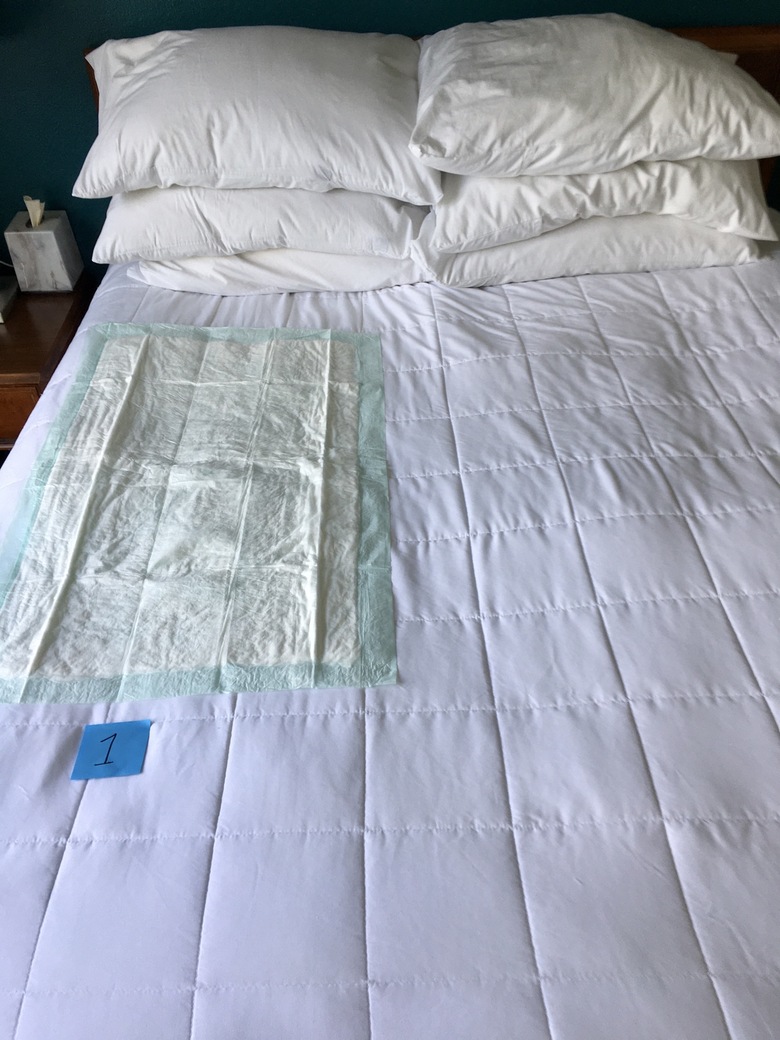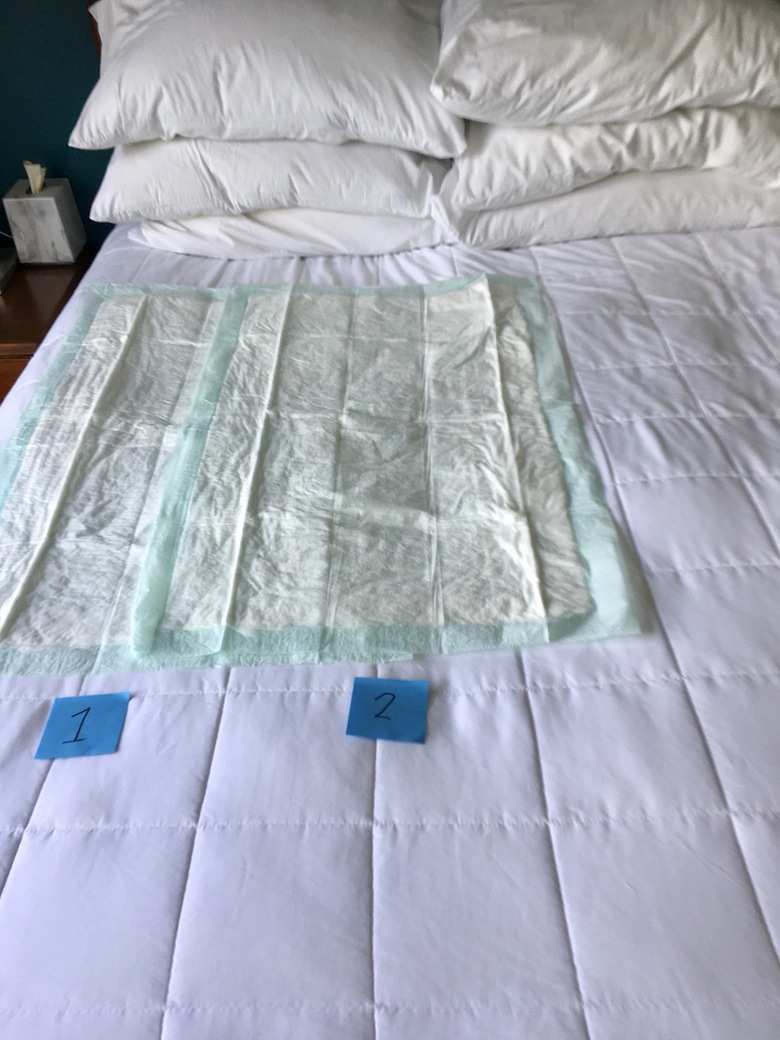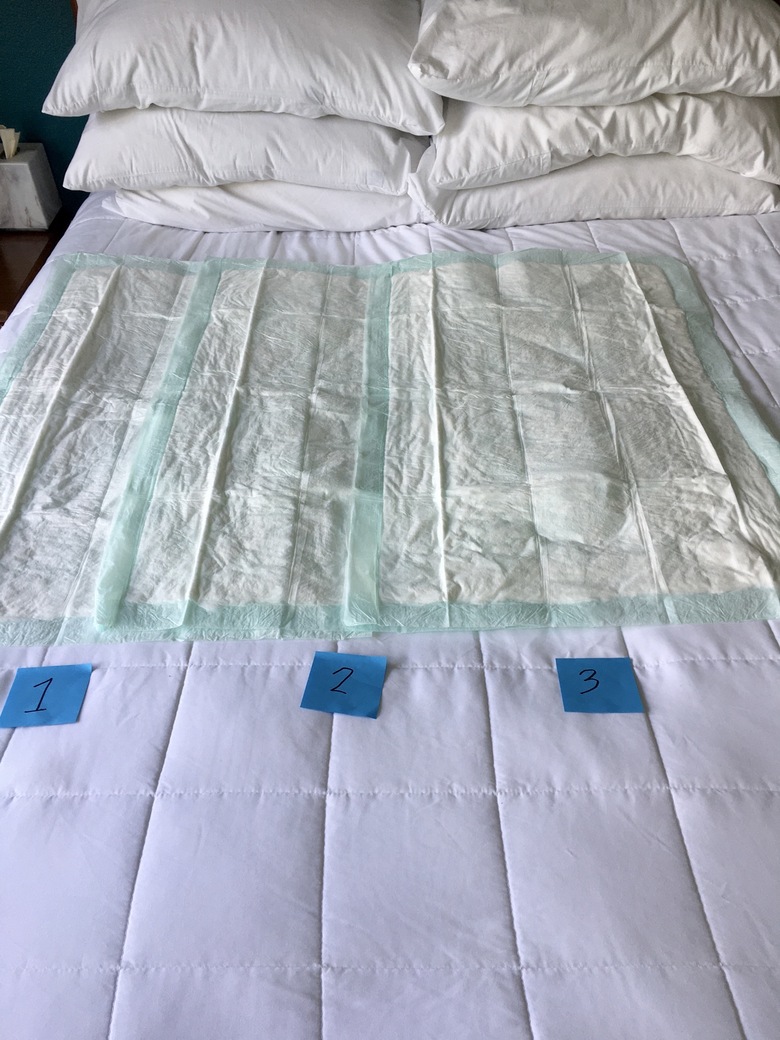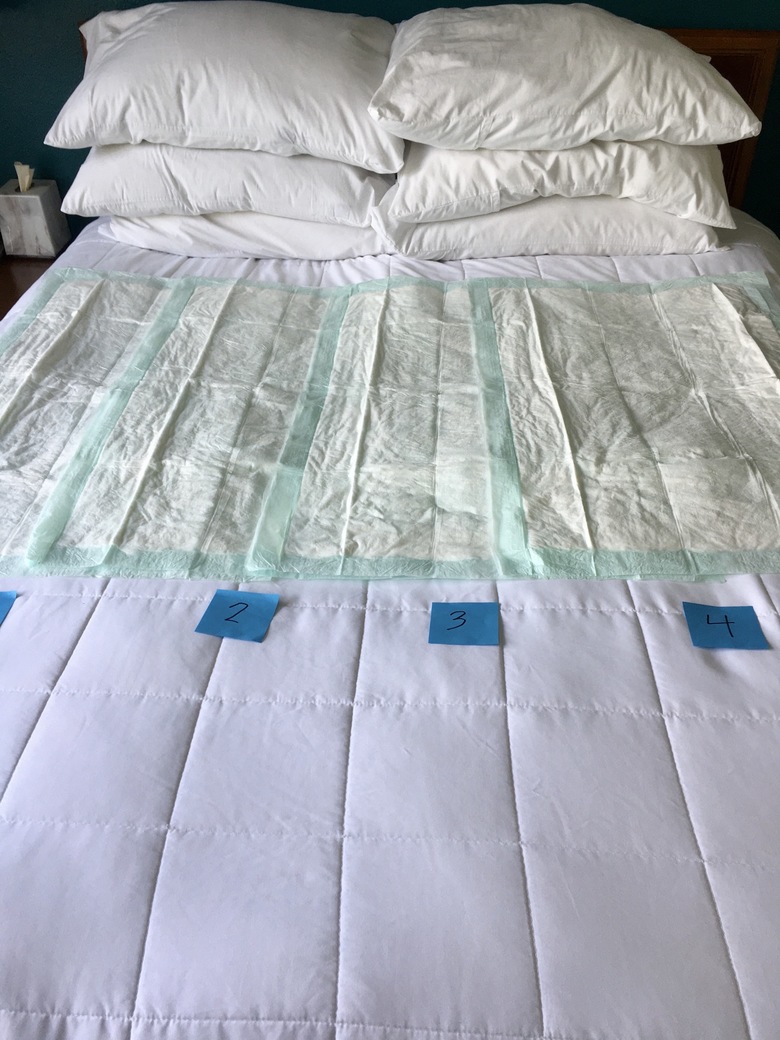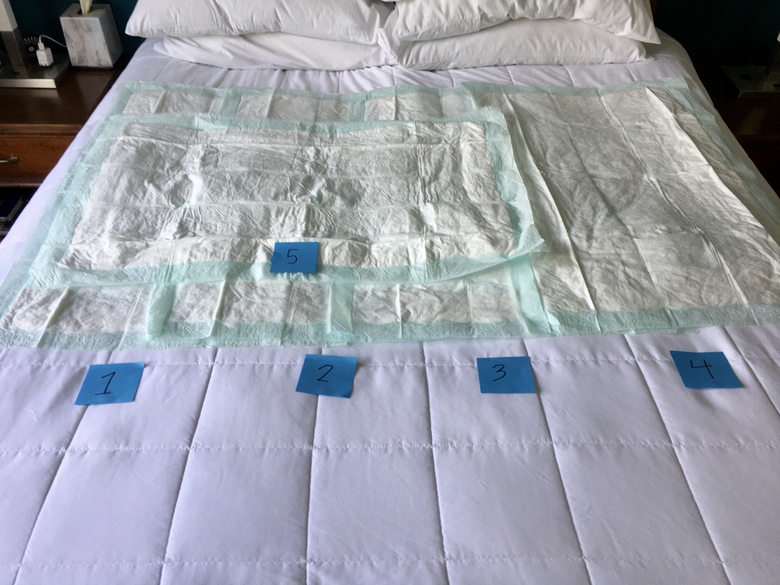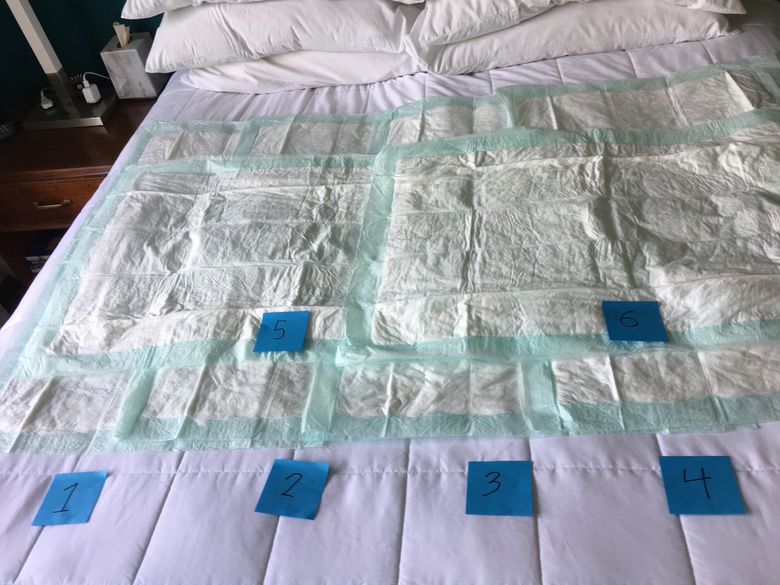Archives1
Staff member
Hi peeps. Recently I told someone I’d post photos of how I’ve learned to weave/layer the disposable bed pads I use, to make for the fastest morning clean-up and the least wet bed in the middle of the night, when I soak through my Depends rather than the more typical waking-up-every-5-to-60 minutes to pee.
I don’t remember which topic heading this discussion was originally under, so I’m just starting a new topic.
I use the Target brand of “chucks,” 23”x36”. I use six per bed layer. The way I pattern them helps me be able to typically just have to remove 1 of the 6 when I wet the bed, and 2-2 at most. With this pattern, I have never wet the mattress.
Here’s the order I have on my mattress:
1. standard waterproof mattress cover
2. felt mattress cover to help sheets and bed pads stay in place
3. set of six chucks
4. fitted sheet
5. another set of six chucks
6. another fitted sheet
7. top sheet
8. another top sheet
9. duvet cover over comforter with synthetic filling
10. duvet cover over comforter with down filling
Yes, I love lots of weight on me at night, and I keep my room very cold, which are two of the top 10 ways to prevent insomnia. But even before I grew up and started caring about chronic insomnia, I always loved lots of bedding. My mom used to call me “The Princess and the Pea.”
The reason I use the two sets of fitted sheets and chucks is so if I wet one set and am in a rush in the morning, I can just rip it all off and still have a clean bed ready to go underneath the top set. Yes, I’m one of those people who makes their bed meticulously first thing every morning or I feel weird all day if I don’t. And some mornings, if the bed is wet, I don’t have time to do laundry immediately. I’ve also found that having two top sheets helps for the same reason: quick, laundry-free bedding changes.
Making the bed, particularly from scratch, is one of my injured lumbar spine’s least favorite, most aggravating activities. So I try to make doing so as easy on myself as possible.
Having duvet covers on my two comforters helps prevent leaks which, sometimes, somehow, even though I’m a female, go upward, from reaching the comforters themselves. I think the peeing upward phenomenon happens because a wet diaper disperses the wetness all around the diaper, including the top of it.
Anyway, washing comforters is a big drag, not good for the laundry machines nor for the comforters. Duvets do help prevent the comforters from getting wet and stained.
About these photos: I’m going to post them in the order I apply the chucks. On each chuck there’s a sticky pad with a number written on it to denote it’s place in the order if the placement. I’ve got this down to enough of a science that I usually only have to change pad 5 or 6. This is on a queen-size bed.
Another thing I do is to only sleep on one side of the bed at a time, so if it gets wet in the middle of the night, rather than remaking the bed in the dark, I just place a permanent, washable, plastic-backed, 46”x60” bed pad on top of my wet fitted sheet so I don’t smell or feel it for the rest of the night. Then I transfer to the other, dry side of the bed. Of course, being able to use both sides of the bed is only possible because I’m single.
I purchased the washable, permanent bed pads at a medical supply store here in Salt Lake City, called Ortho-Med. I‘m sorry I don’t remember the brand of the bedpad and I removed the tags. They’re green on the bottom, and very reliable. The reason I don’t use them all the time instead of the disposable chucks is because I don’t need to do more laundry. Laundry is another of my back’s least favorite activities. Plus wetting the bed still grosses me out. I just want to throw the mess away ASAP and get on with life, which is why I also wear disposable diapers. I’m a pretty die-hard environmentalist, so using disposable products bothers me, but not as much as the smell of rancid pee on materials waiting to be laundered.
The reason I use the 22”x36” size of chucks is because when I’ve tried the larger size, they cost more money per unit. Even though they’re bigger and I’d only need to use three of them in my pattern instead of six of the smaller size, if a big pad gets wet and needs to be thrown away, it ends up costing more than if a smaller size gets wet.
Of course, despite all of my preparation, I still wake up about once a month to all of my bedding being totally soaked, except for the mattress. I passionately despise those nights. But I’m grateful it’s not happening every night like it used to, because over the years I’ve learned what helps. Coping with sudden-onset of bedwetting following a catastrophic injury, was one of the most confusing and disturbing challenges I’ve survived. But I have made so many improvements and adjustments and I sleep better and drier now.
My next improvement project is to refine my diaper choice. I’ve only ever used Depends and Tena. Now that I’ve been more active on this forum, I’ve realized how many other protection choices I have. I’m making a spreadsheet of all the choices, and a tally of the votes posted here in favor of each product. Then I’ll order samples to see what helps me most. When I’m finished, I’ll post the spreadsheet.
I hope my bedding technique suggestions may help someone currently on this forum, and also new members in the future.
Hugs and compassion!
I don’t remember which topic heading this discussion was originally under, so I’m just starting a new topic.
I use the Target brand of “chucks,” 23”x36”. I use six per bed layer. The way I pattern them helps me be able to typically just have to remove 1 of the 6 when I wet the bed, and 2-2 at most. With this pattern, I have never wet the mattress.
Here’s the order I have on my mattress:
1. standard waterproof mattress cover
2. felt mattress cover to help sheets and bed pads stay in place
3. set of six chucks
4. fitted sheet
5. another set of six chucks
6. another fitted sheet
7. top sheet
8. another top sheet
9. duvet cover over comforter with synthetic filling
10. duvet cover over comforter with down filling
Yes, I love lots of weight on me at night, and I keep my room very cold, which are two of the top 10 ways to prevent insomnia. But even before I grew up and started caring about chronic insomnia, I always loved lots of bedding. My mom used to call me “The Princess and the Pea.”
The reason I use the two sets of fitted sheets and chucks is so if I wet one set and am in a rush in the morning, I can just rip it all off and still have a clean bed ready to go underneath the top set. Yes, I’m one of those people who makes their bed meticulously first thing every morning or I feel weird all day if I don’t. And some mornings, if the bed is wet, I don’t have time to do laundry immediately. I’ve also found that having two top sheets helps for the same reason: quick, laundry-free bedding changes.
Making the bed, particularly from scratch, is one of my injured lumbar spine’s least favorite, most aggravating activities. So I try to make doing so as easy on myself as possible.
Having duvet covers on my two comforters helps prevent leaks which, sometimes, somehow, even though I’m a female, go upward, from reaching the comforters themselves. I think the peeing upward phenomenon happens because a wet diaper disperses the wetness all around the diaper, including the top of it.
Anyway, washing comforters is a big drag, not good for the laundry machines nor for the comforters. Duvets do help prevent the comforters from getting wet and stained.
About these photos: I’m going to post them in the order I apply the chucks. On each chuck there’s a sticky pad with a number written on it to denote it’s place in the order if the placement. I’ve got this down to enough of a science that I usually only have to change pad 5 or 6. This is on a queen-size bed.
Another thing I do is to only sleep on one side of the bed at a time, so if it gets wet in the middle of the night, rather than remaking the bed in the dark, I just place a permanent, washable, plastic-backed, 46”x60” bed pad on top of my wet fitted sheet so I don’t smell or feel it for the rest of the night. Then I transfer to the other, dry side of the bed. Of course, being able to use both sides of the bed is only possible because I’m single.
I purchased the washable, permanent bed pads at a medical supply store here in Salt Lake City, called Ortho-Med. I‘m sorry I don’t remember the brand of the bedpad and I removed the tags. They’re green on the bottom, and very reliable. The reason I don’t use them all the time instead of the disposable chucks is because I don’t need to do more laundry. Laundry is another of my back’s least favorite activities. Plus wetting the bed still grosses me out. I just want to throw the mess away ASAP and get on with life, which is why I also wear disposable diapers. I’m a pretty die-hard environmentalist, so using disposable products bothers me, but not as much as the smell of rancid pee on materials waiting to be laundered.
The reason I use the 22”x36” size of chucks is because when I’ve tried the larger size, they cost more money per unit. Even though they’re bigger and I’d only need to use three of them in my pattern instead of six of the smaller size, if a big pad gets wet and needs to be thrown away, it ends up costing more than if a smaller size gets wet.
Of course, despite all of my preparation, I still wake up about once a month to all of my bedding being totally soaked, except for the mattress. I passionately despise those nights. But I’m grateful it’s not happening every night like it used to, because over the years I’ve learned what helps. Coping with sudden-onset of bedwetting following a catastrophic injury, was one of the most confusing and disturbing challenges I’ve survived. But I have made so many improvements and adjustments and I sleep better and drier now.
My next improvement project is to refine my diaper choice. I’ve only ever used Depends and Tena. Now that I’ve been more active on this forum, I’ve realized how many other protection choices I have. I’m making a spreadsheet of all the choices, and a tally of the votes posted here in favor of each product. Then I’ll order samples to see what helps me most. When I’m finished, I’ll post the spreadsheet.
I hope my bedding technique suggestions may help someone currently on this forum, and also new members in the future.
Hugs and compassion!

